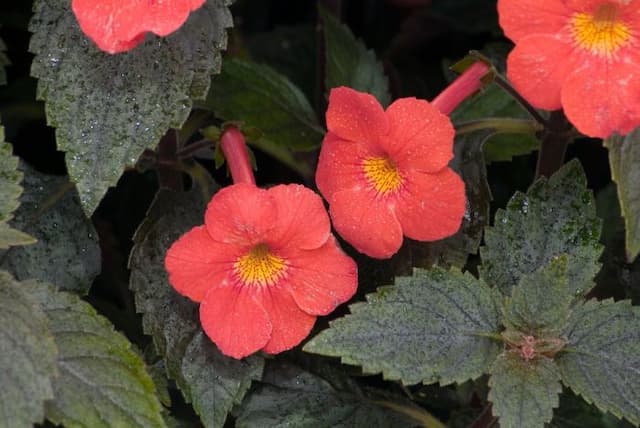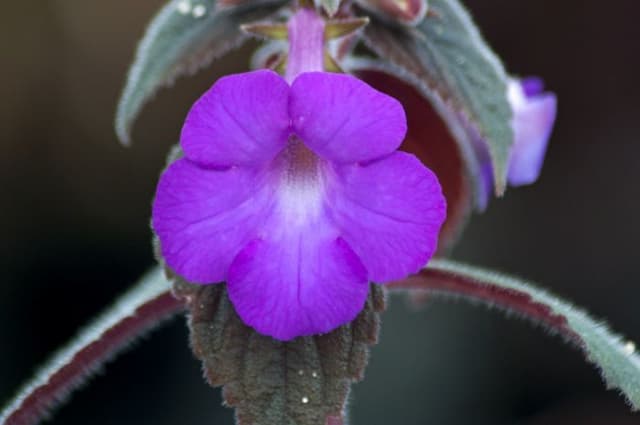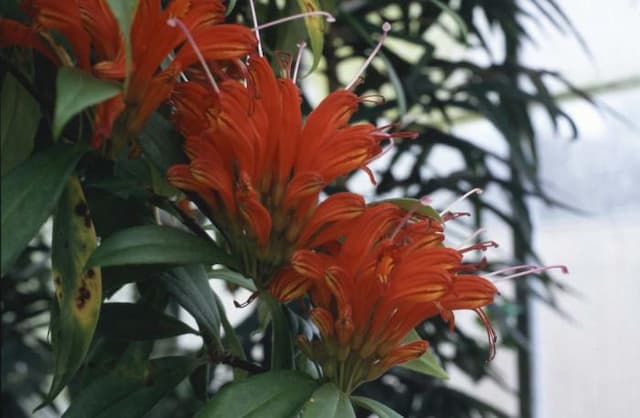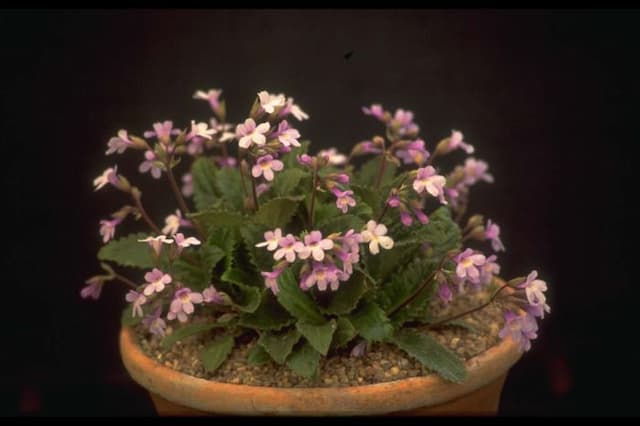Brazilian Edelweiss Sinningia canescens
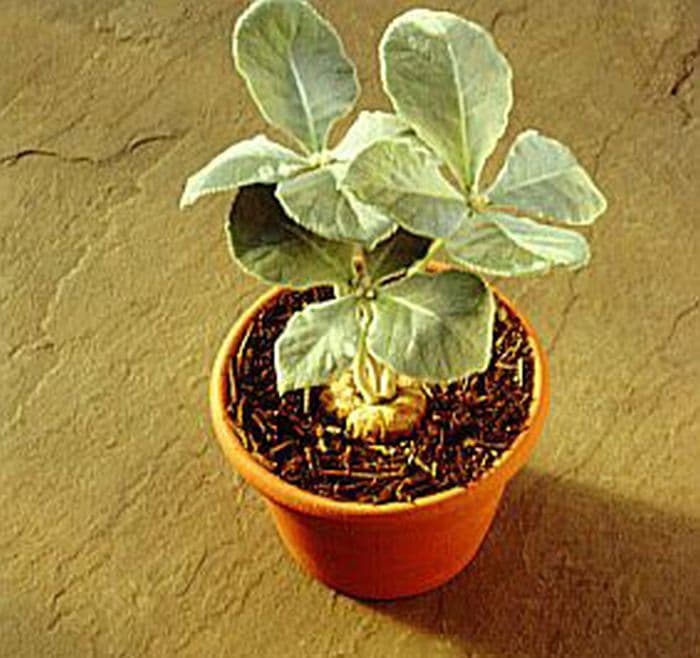
ABOUT
Sinningia canescens, commonly known as Brazilian Edelweiss, is a distinctive plant known for its notable appearance. The plant typically displays velvety leaves that are covered with fine hairs, giving them a soft, silvery-grey look. These hairs confer a unique texture to the foliage that is quite pleasing to the touch. The leaves grow in a rosette pattern that emerges from a tuberous base, spreading outward in a lush and full arrangement. The Brazilian Edelweiss produces attractive flowers that are tubular in shape and can vary in color from white to pale pink. These flowers are typically borne in clusters on erect stems that rise above the rosette of leaves, creating a lovely contrast between the blooms and the foliage. The blossoms are known for their subtle beauty and can attract hummingbirds and other pollinators to the garden. The overall appearance of the Brazilian Edelweiss is one of delicate elegance and softness, partly due to the downy leaves and the gentle hues of the flowers. It could be likened to a small, soft-hued oasis of fuzziness that brings an alpine aesthetic to its environment. Despite its appearance, Sinningia canescens is generally considered a hardy plant that has a specialized growth form fitting for collectors and enthusiasts who appreciate its unique beauty.
About this plant
 Names
NamesFamily
Gesneriaceae
Synonyms
Brazilian Edelweiss, Ashy Sinningia
Common names
Sinningia canescens.
 Toxicity
ToxicityTo humans
The Brazilian Edelweiss (Sinningia canescens) is not widely known for its toxicity to humans. There is limited information about its potential toxic effects if ingested, and it does not seem to appear on prominent lists of poisonous plants. However, it is always advisable to avoid ingesting unknown plants or plant parts due to potential risks. If someone has ingested Brazilian Edelweiss and is showing adverse symptoms, it is important to seek medical attention.
To pets
The Brazilian Edelweiss (Sinningia canescens) does not have a well-documented profile of toxicity in pets. There is a scarcity of information regarding its potential poisonous effects on animals such as dogs and cats. It is generally recommended to prevent pets from ingesting plants, particularly if their toxicity is unclear. If a pet has consumed Brazilian Edelweiss and exhibits signs of illness, it is crucial to contact a veterinarian.
 Characteristics
CharacteristicsLife cycle
Perennials
Foliage type
Deciduous
Color of leaves
Green
Flower color
White
Height
1 foot (30 cm)
Spread
1 foot (30 cm)
Plant type
Bulb
Hardiness zones
10
Native area
Brazil
Benefits
 General Benefits
General Benefits- Aesthetic Appeal: Sinningia canescens, commonly known as Brazilian Edelweiss, adds visual interest to gardens and homes with its attractive grey-green foliage and white to pale pink flowers.
- Easy Care: This plant is relatively low-maintenance, making it suitable for gardeners of all skill levels.
- Compact Size: Its small size makes it an excellent choice for indoor containers or small outdoor spaces.
- Drought Tolerance: Brazilian Edelweiss is known for its ability to survive in dry conditions once established, making it ideal for water-wise gardens.
- Attracts Pollinators: The flowers of Sinningia canescens attract hummingbirds and bees, promoting biodiversity.
- Seasonal Interest: The plant has a particular season when it blooms, providing a specific time to look forward to its floral display each year.
 Medical Properties
Medical PropertiesThis plant is not used for medical purposes.
 Air-purifying Qualities
Air-purifying QualitiesThis plant is not specifically known for air purifying qualities.
 Other Uses
Other Uses- The leaves of the Brazilian Edelweiss can be used to create natural dyes for textiles, providing various shades of green depending on the mordant used.
- The plant's fibrous stems may be utilized in the manufacture of paper, offering an eco-friendly alternative to traditional wood pulp.
- Brazilian Edelweiss can be cultivated as a ground cover in shady garden areas due to its low growth habit and attractive foliage.
- Its unique, woolly leaves might be employed in crafts or as a natural stuffing material for small pillows or toys.
- The fuzzy leaves of the Brazilian Edelweiss can be used educationally to demonstrate plant adaptations in areas with high sunlight exposure.
- Incorporated into botanical drawings and photography, the Brazilian Edelweiss adds texture and interest as a subject because of its distinctive appearance.
- This plant is suitable for inclusion in living walls or vertical gardens, particularly in environments that simulate its native habitat.
- The Brazilian Edelweiss could potentially be used as a biological indicator for certain environmental conditions, like air humidity levels, due to its preference for specific growing conditions.
- The tubers of the Brazilian Edelweiss, being naturally protected by a thick layer of fur, can be studied for insights into natural protection mechanisms for plant roots.
- As a conversation piece, the Brazilian Edelweiss's white coating and unique texture can be the basis for discussions on plant diversity, evolution, and adaptation.
Interesting Facts
 Feng Shui
Feng ShuiSinningia canescens, commonly known as Brazilian Edelweiss, is not used in Feng Shui practice.
 Zodiac Sign Compitability
Zodiac Sign CompitabilitySinningia canescens, commonly known as Brazilian Edelweiss, is not used in astrology practice.
 Plant Symbolism
Plant Symbolism- Resilience: Sinningia canescens, commonly known as Brazilian Edelweiss, has notable durability and can thrive in challenging environments, symbolizing one's ability to endure and adapt to hardships.
- Rarity: As a plant not commonly found in everyday gardens, the Brazilian Edelweiss signifies uniqueness and the rarity of certain traits or qualities within a person.
- Beauty: With its attractive bloom, it represents the beauty that can be found even in tough conditions, reminding us of inner beauty that persists irrespective of external factors.
- Charm: The soft, woolly appearance of its foliage and flowers lends a charming quality, suggesting the endearing traits that can captivate the hearts of others.
- Purity: The Brazilian Edelweiss often carries connotations of purity and innocence, partly due to its white flowers and their resemblance to the Alpine Edelweiss, which shares similar symbolism.
 Water
WaterBrazilian Edelweiss should be watered thoroughly when the top inch of soil feels dry to the touch, usually once every week or two, depending on the environmental conditions. Use room temperature water, and water directly onto the soil to avoid wetting the leaves, which can promote fungal diseases. During its active growing season in spring and summer, water more frequently, as the plant prefers consistently moist but not waterlogged soil. In contrast, in the fall and winter months, reduce watering as the plant enters a dormant phase. Generally, watering with about 8-16 ounces every week during the growing season and reducing to half during dormancy should be sufficient.
 Light
LightBrazilian Edelweiss thrives in bright, indirect light conditions. A spot near an east or west-facing window where the plant receives morning or late afternoon sun is ideal. Avoid direct sunlight, especially during the harsh midday hours, as it can scorch the leaves of the plant. If natural light is insufficient, grow lights can be used to supplement.
 Temperature
TemperatureBrazilian Edelweiss prefers temperatures between 60 and 75 degrees Fahrenheit for optimal growth. It can tolerate a minimum temperature of about 50 degrees Fahrenheit, but temperatures below this can cause harm to the plant. Avoid placing Brazilian Edelweiss in locations with cold drafts or sudden temperature changes, which can stress the plant.
 Pruning
PruningBrazilian Edelweiss benefits from pruning to maintain its shape and promote bushier growth. Prune the plant after it finishes flowering, typically in late summer or early fall. Remove any dead or yellowing leaves to encourage new growth. Avoid heavy pruning; instead, focus on light pruning to shape the plant and remove any excessively long stems. Pruning is not required frequently—once a year is usually enough.
 Cleaning
CleaningAs needed
 Soil
SoilThe best soil mix for Brazilian Edelweiss (Sinningia canescens) should be well-draining, rich in organic matter, and slightly acidic to neutral in pH, ranging from 6.0 to 7.0. A mixture containing peat, perlite, and pine bark in equal parts would provide suitable conditions for its growth.
 Repotting
RepottingBrazilian Edelweiss should be repotted every two to three years or when it has outgrown its current pot. Repotting is best done in the spring or early summer, during the plant’s active growth period.
 Humidity & Misting
Humidity & MistingBrazilian Edelweiss thrives in moderate to high humidity levels, ideally between 50% to 70%. Maintaining these humidity levels will support its lush foliage and encourage healthy growth.
 Suitable locations
Suitable locationsIndoor
Provide bright, indirect light and maintain warmth.
Outdoor
Place in dappled shade and protect from intense sun.
Hardiness zone
10-11 USDA
 Life cycle
Life cycleThe life cycle of Sinningia canescens, commonly known as Brazilian Edelweiss, begins with seed germination, which requires a warm and moist environment to initiate. After germination, the seedling develops into a small rosette, establishing a tuber underground that will serve as a storage organ and anchor for the plant. As the plant matures, it produces fuzzy, silver-grey leaves that grow in a rosette pattern, indicative of its active vegetative growth stage. Following the vegetative stage, the Brazilian Edelweiss enters the flowering stage during warmer months, showcasing tubular, pink-tinged white flowers that attract pollinators. Pollination can result in the production of seeds, allowing for the cycle to repeat. During cold or dry seasons, the plant may enter a dormancy phase, with above-ground foliage dying back, and the tuber resting until favorable conditions return.
 Propogation
PropogationPropogation time
Spring-Early Summer
Propogation: Sinningia canescens, commonly known as Brazilian Edelweiss, is often propagated through its tubers, which is the most popular method. During the dormancy period in winter, the tubers can be divided. This is when the plant has died back and is not actively growing. Gently remove the tuber from the soil and brush off any excess dirt. Using a clean knife, cut the tuber into sections, ensuring that each piece has at least one growth bud. Allow the cut surfaces to dry for a day to avoid rot when replanted. Plant each section of the tuber about an inch (2.54 centimeters) deep in fresh potting mix, and keep the soil moist until new growth appears, indicating successful propagation.
